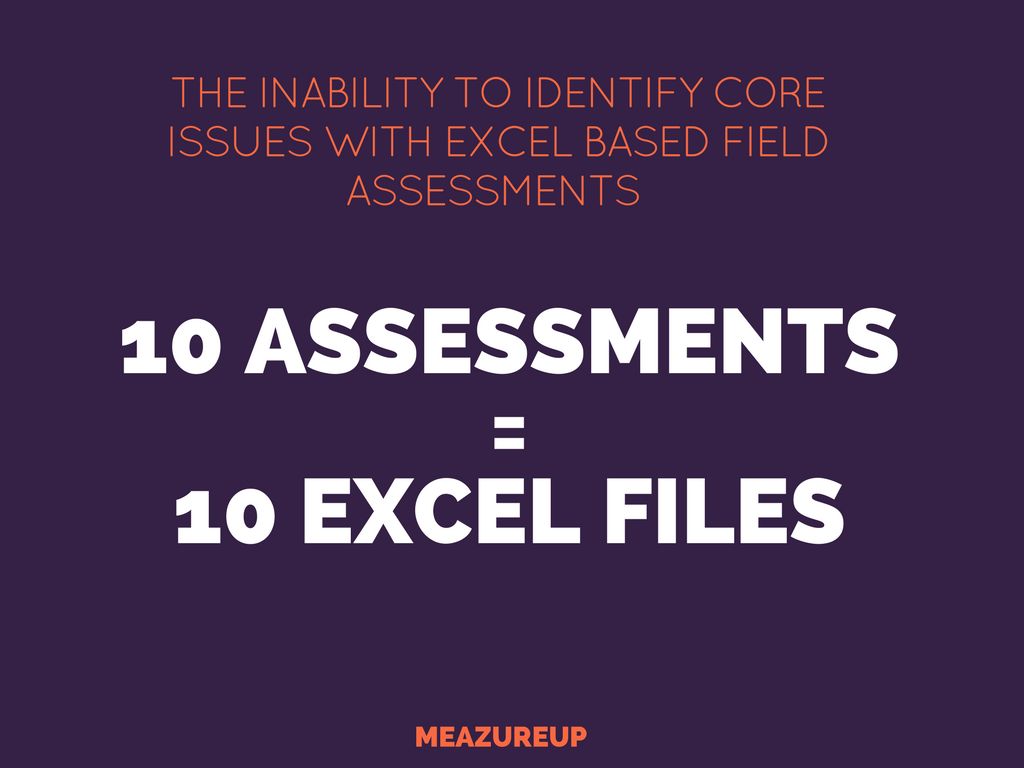
Being able to identify core operational issues across your restaurant chain can be difficult regardless of the size of your organization and yet very important in maintaining consistency in your restaurant operations, and standardization across the chain’s individual locations. Whether you stand at a few or a few hundred locations, having access to the correct data is key to recognizing areas of improvement. More the data, more the chances of identifying trends and, therefore, more scope for making an impact on the issues identified.
Paper and excel based field assessments are traditional methods that have several drawbacks that have been detailed in another article. Below, we elaborate on the limitations of excel based formats in identifying core operational issues that further limit the impact on process improvement mainly due to lack of access to comprehensive quality data in real-time.
Poor data collection methods
The main method of data collection for District Managers (DM) in the field is with hand-written notes. While visiting each store, DM’s use a pen and paper to jot down notes on the store, including the assessment operations checklist. In doing this, data is originally tracked on paper before it can be populated into excel. This entry is done only after a thorough inspection of the entire location is completed. The assessment data are entered into an Excel sheet manually by the DMs. This extremely manual process is prone to human error, more so given the gamut of cells and the complex formulaic nature of spreadsheets in conjunction with the comprehensive nature of these operations checklist.
At the same time, manual entries also result in limitations pertaining to the features of adding pictures, drawing an action plan and assigning tasks which all have to be emailed as attachments. Thus, with an excel based assessment, there is always the possibility that the data compiled is incomplete as additional comments and notes that may illumine certain aspects of the data are attached and sent separately, which could mean incomplete data at one place. Even more importantly, it is the quality of data that is gathered which becomes an issue with an excel based format which can hinder identifying trends and core operational issues that may need corrective actions. This is particularly relevant when you have a large chain of stores and the data from each store needs to be consolidated to identify and standardize operational issues.
Additionally, the types of possible inputs are limited, which hinders the value of the data collected. Excel sheets, as it is, are notorious when dealing with a large amount of data as even a single wrong entry may end up affecting the whole set of data rendering data based analysis useless or misleading. With poor data collection and these inherent difficulties with an excel based assessment procedure, it’s difficult to identify common issues both at individual locations and across the organization.
No business trend scoring
A successful assessment is one that provides sufficient data in an easy manner to analyze trends and look for areas of opportunity. The lack of insight into the trends in restaurant operations can ultimately be detrimental to a restaurant chain attempting to scale and grow. With paper and excel, management is limited in terms of the level of data trending that they can see which is generally incomplete. Leveraging data to identify operational issues is restrictive with excel based assessment as it is unable to provide an accurate analysis.
The general procedure where a Field Manager makes quick notes into a single excel file on an individual store by store basis, cannot create the detailed implications required to identify core issues quickly and efficiently. An automated scoring as with digital solution, in real time, to give a more detailed picture of the compiled data can help analyze and spot trends even before they occur and go a long way in taking corrective and preventive measures towards restaurant operations excellence.
Inability to see aggregated data
Without proper aggregated data, it’s challenging to identify the core issues and trends occurring across the organization. By analyzing single reports, it’s almost impossible to understand which operational components are consistently failing or, alternatively, succeeding. Using paper and excel, each DM can input data for the individual store that they visited. If your chain has 30 locations, you might have 3 different DM’s conducting assessment across your organization. With each DM conducting individual assessments on 10 locations, that’s 30 total Excel files, each with unique and comprehensive scoring, notes and action plans.
The question now becomes, how do you effectively and accurately aggregate these 30 individual reports into a single view? The answer: you can’t. At least not in a timely manner. When these 30 reports are merged, the data in them could be outdated as coordinating the completion of a master Excel file like this is no easy feat. Further, even if one were to consolidate all the data, by the time the consolidation is done, some data become irrelevant or outdated due to the time elapsed in collection and consolidation. Without a bigger picture, it doesn’t make sense to carry out action plans when the ability to identify trends by leveraging the collected data may itself be limited. Data tells a story, but one needs aggregated data available at one place with real-time update possibility to ensure that the story, which relates to restaurant operations checklists and areas of operational improvement here, is reliable and gives a true account of the state of affairs.
These factors point out how the use of excel based assessment can actually prove counterproductive as it might fail to collect accurate, comprehensive and qualitatively high data which will result in inaccurate analysis giving a distorted picture of trends and inevitably fail to identify core operational issues.
Training an entire organization to perform better is difficult without proper data reporting capabilities. A restaurant auditing software can help provide better data analytics in real time as compared to excel based operations auditing.
With a digital field assessment tool, like MeazureUp’s cloud-based auditing app, collection of data is an automated process which ensures an error-free compilation of data, and provides a one-stop solution where each report from each location is aggregated together into a single unified location on a cloud-based platform, making it easy to analyze the data and spot trends to help identify core operational issues. This presents thoughtful data with actionable information to help ensure your restaurant unit’s and the chain’s success.
Click the link below to schedule a time to learn more about how MeazureUp can support your operations.


